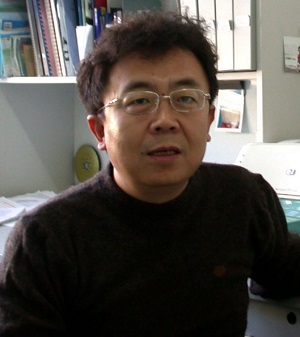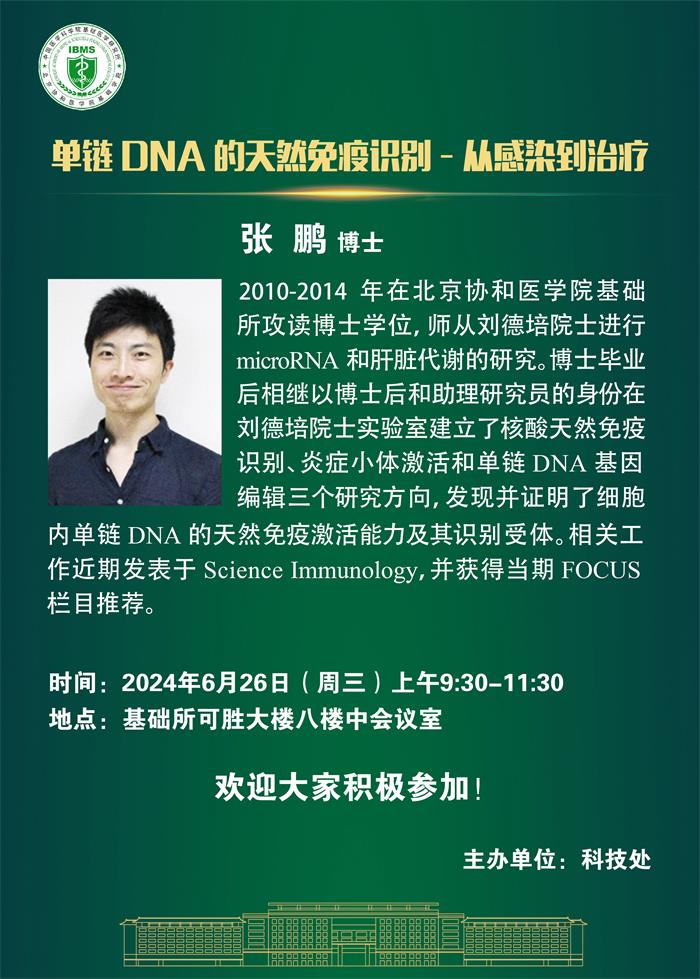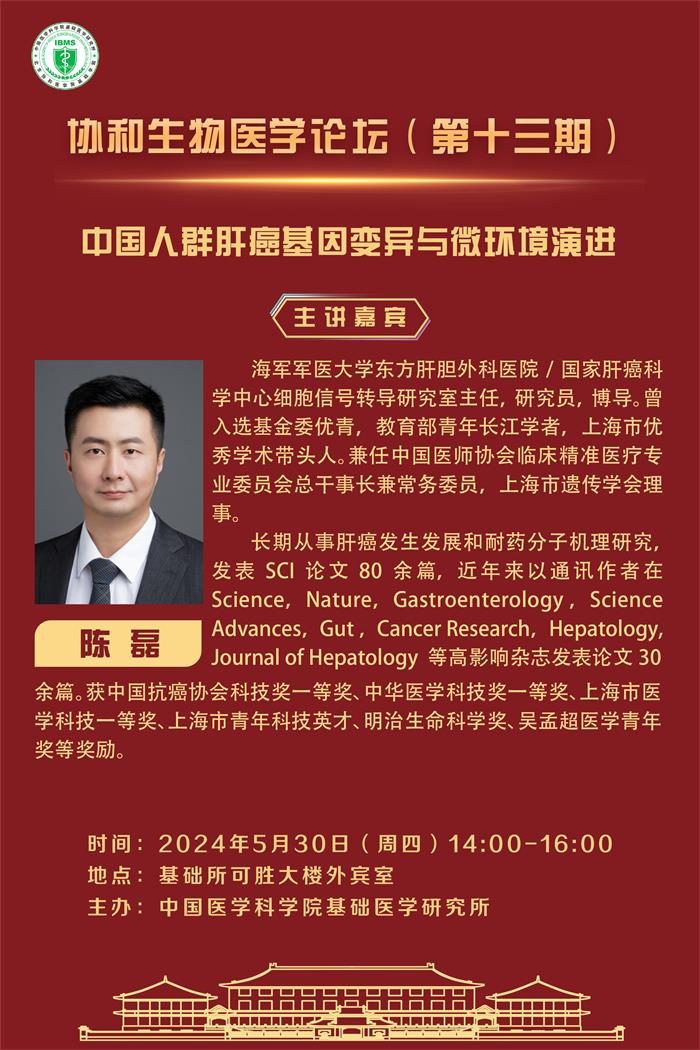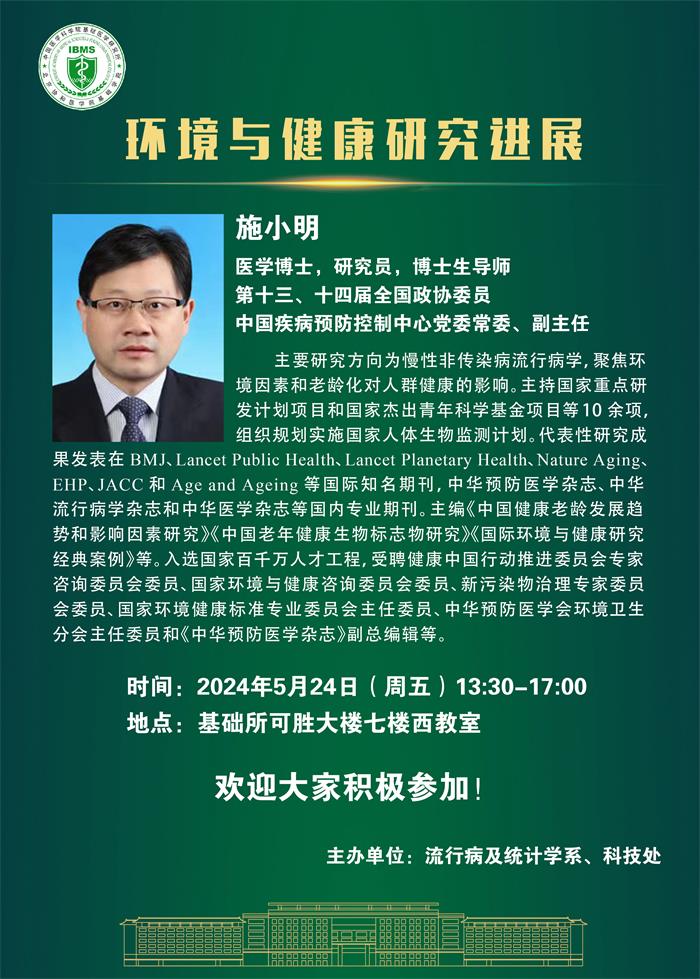韓代書(shū)

韓代書(shū):1983年畢業(yè)于南京大學(xué)生物系。1995年畢業(yè)于法國巴黎大學(xué),獲博士學(xué)位,1995年至1998年美國國立衛生研究院博士后,1999年回中國醫學(xué)科學(xué)院基礎醫學(xué)研究所。現任北京協(xié)和醫學(xué)院教授,博士研究生導師。目前的主要研究方向:生殖系統免疫調節與相關(guān)的不孕不育。
課題組人員
韓睿欽:男,研究助理,
劉艾潔:女,實(shí)驗助理,
陳 冉,女,博士研究生,
王 菲,女,博士研究生,
于曉芹,女,碩士研究生,
張文靜,女,碩士研究生,
研究方向
生殖系統具有特殊的免疫抑制環(huán)境,用以保護生殖細胞不受免疫系統的損傷,但又容易受到微生物病原體的感染。微生物感染與生殖系統炎癥是不孕不育的重要病因。實(shí)驗室研究生殖系統免疫環(huán)境的調節機制,以及微生物感染與炎癥相關(guān)的不孕不育。主要內容包括:睪丸與附睪免疫豁免環(huán)境保護精子發(fā)生的機制;微生物感染與自身免疫反應誘導睪丸炎、附睪炎、精囊炎及前列腺炎的機制;組織特異細胞天然免疫反應及其在誘發(fā)組織炎癥中的作用;揭示生殖系統炎癥破壞精子形成與功能、從而導致男性不育的機制。
目前承擔研究項目
1. “十三五”國家重點(diǎn)研發(fā)專(zhuān)項:干細胞移植的分子免疫調控機理;
2. 國家重點(diǎn)研發(fā)計劃:免疫對配子發(fā)生和胚胎發(fā)育的影響;
3. 中國醫學(xué)科學(xué)院醫學(xué)創(chuàng )新工程項目:組織干細胞衰老關(guān)鍵分子機理及干預研究;
4. 中國醫學(xué)科學(xué)院醫學(xué)“一帶一路”科技先導專(zhuān)項:感染與免疫相關(guān)的不孕不育機制研究。
近五年發(fā)表論文:
1.Fei Wang, Ran Chen, Qian Jiang, Han Wu, Maolei Gong, Weihua Liu, Xiaoqin Yu, Wenjing Zhang, Ruiqin Han, Aijie Liu, Yongmei Chen, Daishu Han. Roles of sialic acid, AXL and MER receptor tyrosine kinases in mumps virus infection of mouse Sertoli and Leydig cells. Front. Microbiol. 2020; 11:1292.
2.Wu H, Jiang X, Gao Y, Liu W, Wang F, Gong M, Chen R, Yu X, Zhang W, Gao B, Song C*, Daishu Han. Mumps virus infection disrupts blood-testis barrier through the induction of TNF-α in Sertoli cells. FASEB J. 2019; 33:12528-12540.
3.Weihua Liu, Fei Wang, Xiaoqin Yu, Han Wu, Maolei Gong, Ran Chen, Wenjing Zhang, Ruiqin Han, Aijie Liu, Yongmei Chen, Daishu Han. Damaged male germ cells induce epididymitis in mice. Asian J Andrology. 2019; 21:1-9.
4.Gong M, Wang F, Liu W, Chen R, Wu H, Zhang W, Yu X, Han R, Liu A, Chen Y, Daishu Han. Pattern recognition receptor-mediated innate immune responses in seminal vesicle epithelial cell and their impacts on cellular function. Biology of Reproduction. 2019; 101, 733-747.
5.Wang F, Liu W, Jiang Q, Gong M, Chen R, Wu H, Han R, Chen Y, Han D. Lipopolysaccharide-induced testicular dysfunction and epididymitis in mice: a critical role of tumor necrosis factor alpha. Biol Reprod. 2018; 100(3):849-861.
6.Liu W, Han R, Wu H, Han D. Viral threat to male fertility. Andrologia. 2018; 50(11):e13140.
7.Jiang Q, Wang F, Shi L, Zhao X, Gong M, Liu W, Song C, Li Q, Chen Y, Wu H, and Han D. C-X-C Motif Chemokine Ligand 10 Produced by Mouse Sertoli Cells in Response to Mumps Virus Infection Induces Male Germ Cell Apoptosis. Cell Death Dis 2017; 8: e3146.
8.Su L, Cheng YC, Lee WM, Zhang M, Yang F, Zhao B, Han D, Liu Y, and Hu D. Abcb1a and Abcb1b Genes Function Differentially in Blood-Testis Barrier Dynamics in the Rat. Cell Death Dis 2017; 8: e3038.
9.Yan K, Feng D, Liang J, Wang Q, Deng L, Zhang X, Ling B, and Han D. Cytosolic DNA Sensor-Initiated Innate Immune Responses in Mouse Ovarian Granulosa Cells. Reproduction 2017; 153: 821-34.
10.王菲,韓代書(shū)。感染及免疫相關(guān)的男性不育。中國科學(xué):生命科學(xué),2017; 47:180-189
11.Wu H, Zhao X, Wang F, Jiang Q, Shi L, Gong M, Liu W, Gao B, Song C, Li Q, Chen Y, and Han D. Mouse Testicular Cell Type-Specific Antiviral Response against Mumps Virus Replication. Front Immunol 2017; 8: 117.
12.江倩, 趙祥, 薛社普, 韓代書(shū). 睪丸免疫調節與睪丸炎: Tyro3/Axl/Mer 受體酪氨酸激酶與模式識別受體的功能. 科學(xué)通報, 2017; 62: 1153–1162
13.Ma W, Li S, Ma S, Jia L, Zhang F, Zhang Y, Zhang J, Wong G, Zhang S, Lu X, Liu M, Yan J, Li W, Qin C, Han D, Qin C, Wang N, Li X, and Gao GF. Zika Virus Causes Testis Damage and Leads to Male Infertility in Mice. Cell, 2016; 167: 1511-24.
14.Wang Q, Wu H, Cheng L, Yan K, Shi L, Zhao X, Jiang Q, Wang F, Chen Y, Li Q, Han D. Mumps virus induces innate immune responses in mouse ovarian granulosa cells through the activation of Toll-like receptor 2 and retinoic acid-inducible gene I. Mol Cell Endocrinol. 2016; 436:183-94.
15.Cheng L, Chen Q, Zhu W, Wu H, Wang Q, Shi L, Zhao X, Han D. Toll-like Receptors 4 and 5 Cooperatively Initiate the Innate Immune Responses to Uropathogenic Escherichia coli Infection in Mouse Epididymal Epithelial Cells. Biol Reprod. 2016; 94:58.
16.Li N, Mruk DD, Mok KW, Li MW, Wong CK, Lee WM, Han D, Silvestrini B, Cheng CY. Connexin 43 reboots meiosis and reseals blood-testis barrier following toxicant-mediated aspermatogenesis and barrier disruption. FASEB J. 2016; 30:1436-52.
17.Chen Q, Deng T, Han D. Testicular immunoregulation and spermatogenesis. Semin Cell Dev Biol. 2016. pii: S1084-9521(16)30019-2.
18.Wu H, Shi L, Wang Q, Cheng L, Zhao X, Chen Q, Jiang Q, Feng M, Li Q, Han D. Mumps virus-induced innate immune responses in mouse Sertoli and Leydig cells. Sci Rep. 2016; 6:19507
19.Deng T, Chen Q, Han D. The roles of TAM receptor tyrosine kinases in the mammalian testis and immunoprivileged sites. Front Biosci (Landmark Ed). 2016; 21:316-27.
20.Li N, Mruk DD, Mok KW, Li MW, Wong CK, Lee WM, Han D, Silvestrini B, Cheng CY. Connexin 43 reboots meiosis and reseals blood-testis barrier following toxicant-mediated aspermatogenesis and barrier disruption. FASEB J. 2016; 30:1436-52.
21.Yan K, Cheng L, Liu P, Liu Z, Zhao S, Zhu W, Wang Q, Wu H, Han D. Polyinosinic-Polycytidylic Acid Perturbs Ovarian Functions Through Toll-Like Receptor 3-Mediated Tumor Necrosis Factor A Production in Female Mice. Biol Reprod. 2015; 93:11.
22.Li N, Mruk DD, Wong CK, Lee WM, Han D, Cheng CY. Actin-bundling protein plastin 3 is a regulator of ectoplasmic specialization dynamics during spermatogenesis in the rat testis. FASEB J. 2015; 29:3788-805.
23.Li N, Mruk DD, Wong CK, Han D, Lee WM, Cheng CY. Formin 1 Regulates Ectoplasmic Specialization in the Rat Testis Through Its Actin Nucleation and Bundling Activity. Endocrinology. 2015; 156:2969-83.
24.Zhu W, Zhao S, Liu Z, Cheng L, Wang Q, Yan K, Chen Q, Wu H, Han D. Pattern recognition receptor-initiated innate antiviral responses in mouse epididymal epithelial cells. J Immunol. 2015; 194:4825-35.
25.Liu Z, Zhao S, Chen Q, Yan K, Liu P, Li N, Cheng CY, Lee WM, Han D. Roles of Toll-like receptors 2 and 4 in mediating experimental autoimmune orchitis induction in mice. Biol Reprod. 2015; 92:63.
26.Yu L, Liu P, Liu Z, Zhu W, Yan K, Chen Q, Han D. p204-mediated innate antiviral responses in mouse adipose cells and their effects on cell functions. Immunol Cell Biol. 2015; 93:147-57.
27.Li N, Liu Z, Zhang Y, Chen Q, Liu P, Cheng CY, Lee WM, Chen Y, Han D. Mice lacking Axl and Mer tyrosine kinase receptors are susceptible to experimental autoimmune orchitis induction. Immunol Cell Biol. 2015; 93:311-20.
著(zhù)作章節
1. Han D, Liu Z, Yan K. Immunology of the Testis and Privileged Sites. 2016, In: Ratcliffe M.J.H (Editor in Chief), Encyclopedia of Immunobiology, Vol. 5, pp. 46-53. Oxford: Academic Press.
2. Deng T, Han D. Testicular Immune Environment for Spermatogenesis. 2016, In: Gladys Robinson (Editor), Spermatogenesis: Molecular Mechanisms, Regulation and Biological Perspectives, pp. 71-100. Nova publishers.
3. Jiang Q, Han D. Infectious and immunological aspects of male infertility. 2017,In: Manuela Simoni and Ilpo Huhtaniemi (Editor), Endocrinology of the Testis and Male Reproduction. In press. Springer publishers.
4. Wang F, Jiang Q, Han D. Testicular immunoregulation: The role of Tyro3, Axl, and Mer receptor tyrosine kinases and pattern recognition receptors. 2018; In: Yan C Cheng (Editor), Spermatogenesis: Biology and Clinical Implications. p51-61. Springer.
5. Gong M, Han D. Immune Environment in the Testis. 2018, In: Yan C Cheng (Editor), Molecular Mechanisms in Spermatogenesis, Second Edition. Springer.
6. Wang F, Chen R, Han D. Innate immune defense in the male reproductive system and male fertility. 2019, In: SK, Saxena (Editor), Innate Immunity in Health and Disease. IntechOpen publishers.
7. Wang F, Chen R, Han D. Phagocytosis of Sertoli cells: a critical event for spermatogenesis. 2019, In: Male Reproductive Health, 10.5772/intechopen.86808. IntechOpen Publishers.
8. Chen R, Wang F, Han D. Immunological function of Leydig cells. 2020, In: Brono Solomon (Editor), Leydig cells: Structure, Functions and Clinical Aspects, p1-25. Nova Science Publishers.





